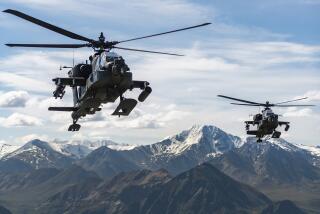U.S. Apache Pilots Train in Korea
- Share via
CAMP HUMPHREYS, South Korea — Dunked upside down in cockpit seats to the bottom of a swimming pool, two U.S. Army helicopter pilots shed their straps, unhook their helmets and swim out through plexiglass side panels to safety.
The maneuver, a simulation of an escape from an ocean crash, usually lasts five to six seconds. It’s vital training for the only U.S. military pilots of AH-64A Apache helicopters who regularly fly missions over water.
The $14.5-million aircraft, a two-seater made by Boeing, is a veteran of the 1989 invasion of Panama, the 1991 Gulf War and peacekeeping in Bosnia. It was originally designed to destroy armored targets on land.
“We turn tanks into scrap metal; that’s our job,” said Chief Warrant Officer 2 Chad J. Copeland of Orlando, Fla. His craft has the firepower to back his bravado: Hellfire missiles, 70-mm rockets, Stinger air-to-air missiles and a 30-mm machine gun.
But in the event of war with North Korea, the dozens of Apaches based in South Korea could engage in a unique task: offshore combat against North Korean patrol boats, landing craft and mini-submarines expected to stream down to try to drop special forces on South Korean soil.
Training goes on for the 37,000 American military personnel in the south even though tensions have eased since North Korea, desperate for economic aid, made unprecedented political contacts last year with South Korea and its chief ally, the United States. Reconciliation efforts have stalled in recent months.
North Korea’s military, a behemoth of more than 1 million soldiers, lacks training because it is short of fuel and spare parts. Many tanks and other vehicles are based on Soviet or Chinese designs from the 1950s and 1960s.
In contrast, Apache pilots of the 6th Cavalry Brigade at Camp Humphreys near Pyongtaek, 43 miles south of Seoul, fly several hundred hours a year. That’s twice as much as their colleagues in the United States.
At night, Apache crews often zip at 140 miles an hour among islets off South Korea’s east and west coasts, 120 feet above the water. They carry infrared night vision gear, consisting of monocles attached to $13,000 helmets and linked to a swiveling camera in the helicopter nose.
South Korean EP-3 surveillance planes--the same as the U.S. spy craft that collided with a Chinese fighter jet April 1 near China’s Hainan island--sometimes help guide the Apaches.
“We’ve kind of pushed the boundaries of the original mission there,” Maj. Stephen Wilson, an Apache pilot from Rogers, Ark., said of the sea flights. “We’ve just exploited another way to use the weapon in the defense of this theater.”
The helicopters, which fly low at relatively slow speeds, would be more exposed at sea than in combat over land. The pilots, however, say the guns of many North Korean navy boats have a range of only 2 1/2 miles, while the Apaches’ Hellfire missiles have twice that range.
Every year the pilots must take a dip in the “Dunker,” a $500,000 hydraulic simulator designed like an Apache cockpit that helps them prepare for a crash at sea.
Trainees, some stationed in Japan, practice escaping from the machine half a dozen times, sometimes without the aid of a small scuba tank stored in a pouch of their flight suits. They also wear goggles with lenses that have been painted over.
“Some of these guys get hung up, scared, some of the equipment doesn’t work, but that’s OK because we have an instructor right behind them,” said Copeland, the program’s director.
At a recent session, instructors deemed the pool too cold--a couple of pilots were shivering--and turned up the water temperature a few notches to just under 70 degrees.
The seas off the Korean peninsula are twice as cold at this time of year, and a lot choppier. The pilot of a ditched Apache faces hypothermia unless swiftly plucked from the waves.
To escape, he must pull a handle inside the Kevlar-coated cockpit that blows out the windows by detonating explosive tape along the frames. Pilots can also pound the plexiglass with their fists or survival knives.
There are 48 Apaches in South Korea. A third Korea-based squadron of 24 craft will return this year from the United States with an upgraded version of the attack helicopter.
More to Read
Sign up for Essential California
The most important California stories and recommendations in your inbox every morning.
You may occasionally receive promotional content from the Los Angeles Times.













